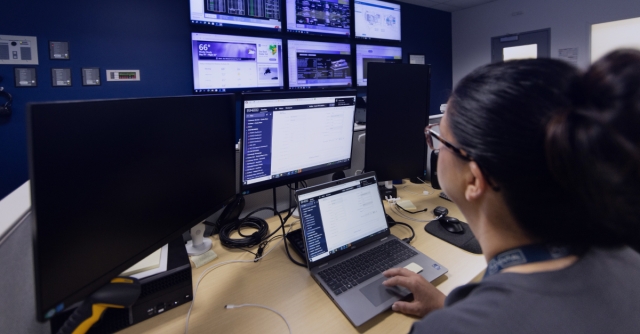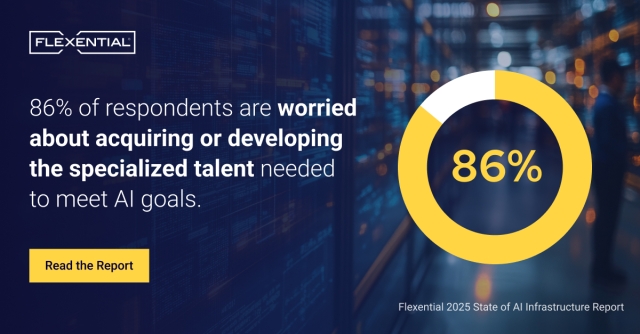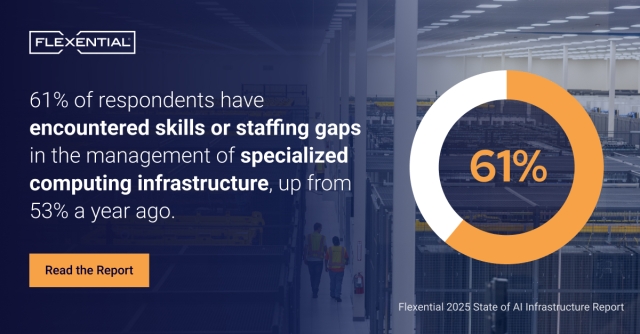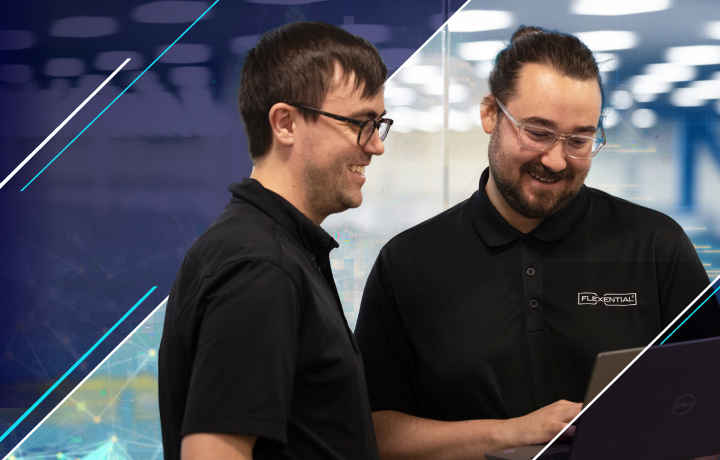Mind the gap: Why solving the AI talent shortage is critical to innovation
AI initiatives are moving faster than the people who support them. The State of AI Infrastructure Report from Flexential reveals how talent gaps across IT, data science, and cybersecurity are becoming the biggest risk to enterprise-scale AI—and what leaders can do about it.

Over the past two posts in our AI Infrastructure series, we explored how executive leadership is reshaping AI priorities and why infrastructure readiness is becoming a strategic battleground. But there’s another piece of the AI puzzle that could determine success or failure: people.
The Flexential State of AI Infrastructure Report uncovers a sobering truth—most organizations don’t have the internal talent they need to execute their AI vision. The pressure to innovate is growing, but the workforce isn’t keeping up. In this post, we dive into the skills gap that’s threatening enterprise AI momentum—and how forward-thinking companies are responding.
A lack of talent could undermine big AI ambitions
AI strategies are being shaped at the highest levels, with C-suite leaders driving vision and budget (as we covered in blog #1, The c-suite steps up: How executives are taking control of the AI agenda). Infrastructure investments are being made to support these ambitions (see blog #2, The new race for AI capacity: Why smart infrastructure planning starts now). But when it comes time to deploy models, tune infrastructure, and secure new workloads, a lack of skilled personnel is slowing progress.
Only 14% of IT decision-makers say they have the people they need to support and scale AI across the business. That’s a striking mismatch between ambition and execution readiness.
The report highlights three core workforce gaps:
- 61% lack infrastructure professionals experienced with high-density, high-power environments
- 53% lack sufficient data science and engineering expertise
- 47% report cybersecurity skill gaps tied to AI-specific threats and compliance needs
These aren’t minor shortfalls—they represent fundamental constraints that can delay timelines, inflate costs, and limit the scope of AI deployments.
AI is transforming the workforce in real time
Unlike past IT transformations, AI is rewriting job roles across nearly every function, from DevOps and analytics to legal, HR, and customer support. But while the technology evolves rapidly, workforce training hasn’t kept pace.
The challenge is twofold:
- AI introduces net-new skills—like prompt engineering, model optimization, and managing GPU environments.
- It raises the bar on existing roles, requiring deeper cross-functional collaboration and more nuanced decision-making.
Organizations are also navigating the tension between automation and human labor. While AI can enhance productivity, it can also overwhelm teams who are now responsible for managing and explaining complex systems they were never trained to support.
Burnout and bottlenecks are growing
The pressure on IT and infrastructure teams is especially acute. With only a limited pool of AI-proficient professionals, existing team members are being asked to support both legacy systems and AI workloads, often without additional headcount.
This dynamic is contributing to real business risk:
- Delayed rollouts due to overextended teams
- Reduced experimentation as teams focus on maintenance over innovation
- Increased vendor dependency due to limited in-house expertise
The result? Slower time to value and greater exposure to operational and reputational risk.
Enterprises are embracing upskilling—but it’s uneven
To close the gap, many organizations are investing in internal training. According to the report, two-thirds now offer in-house AI training programs, from technical bootcamps and vendor certifications to hands-on experimentation environments.
This is an encouraging trend—but access is far from equal. The report reveals a generational divide:
- 47% of Millennials and 40% of Gen Z employees report receiving formal AI training
- Only 22% of Baby Boomers say the same
This disparity raises broader questions about inclusion, succession planning, and knowledge retention. It’s not just about filling open roles—it’s about preparing the entire organization to adapt and thrive.
The role of AI-driven tools in reducing the burden
While solving the talent gap won’t happen overnight, some relief is coming from the tools themselves. A growing number of infrastructure platforms now include AI-driven automation, recommendations, and self-service workflows that lower the technical barrier for everyday users.
But automation isn’t a silver bullet. These tools still require oversight, integration, and governance—all of which depend on knowledgeable, empowered teams.
A human-centered AI strategy is the only sustainable path forward
As enterprise AI enters a new phase of maturity, it’s clear that people—not just platforms—are at the center of long-term success. Building AI infrastructure without building AI fluency across teams is a recipe for underperformance.
The most successful organizations in the report are treating talent as a pillar of AI strategy, not a side effect. They’re investing in workforce development with the same intensity they bring to infrastructure and security—and it’s paying off in innovation, agility, and resilience.
Download the full report: Explore the human side of AI strategy
Get detailed insights into how 350+ IT leaders are addressing the AI skills gap—from in-house training strategies to changing team structures and upskilling roadmaps.
Download the Flexential State of AI Infrastructure Report
Explore the full blog series on the State of AI Infrastructure!
This post is part of our multi-part blog series unpacking the key findings from the Flexential State of AI Infrastructure Report. Each post tackles a core pillar of enterprise AI readiness—from strategy and infrastructure to talent, security, and sustainability.
Executive Leadership & AI Investment
The c-suite steps up: How executives are taking control of the AI agenda
Explore why leadership is the #1 driver of AI growth—and how investment priorities are shifting fast.
Infrastructure & Capacity Planning
The new race for AI capacity: Why smart infrastructure planning starts now
Discover why planning ahead is critical as infrastructure becomes the top bottleneck for AI at scale.
AI Talent & Workforce Strategy
Mind the gap: Why solving the AI talent shortage is critical to innovation
Learn how organizations are navigating workforce shortages, burnout, and upskilling in the AI era.
Network & Security Readiness – Coming Soon!
Beyond bandwidth: Rethinking network and security strategies for the AI era
See how enterprises are upgrading connectivity, adopting zero-trust, and securing distributed AI workloads.
Sustainability & Energy Efficiency – Coming Soon!
Balancing power and progress: Building sustainable AI infrastructure that lasts
Understand how leaders are aligning ESG goals with power, cooling, and performance demands.
Want the full story? Get all the data, charts, and insights in the full report:








